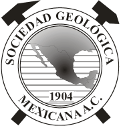|
BOLETÍN DE LA SOCIEDAD GEOLÓGICA MEXICANA, V. 53, n. 1, (2000) 27-58 http://dx.doi.org/10.18268/BSGM2000v53n1a2 |
|
Geocronología y características geoquímicas de las rocas magmáticas terciarias de la Sierra Madre del Sur*
Dante J. Morán-Zenteno1, Barbara Martiny1, Gustavo Tolson1, Gabriela Solís-Pichardo1, Leticia Alba-Aldave1, Ma. del Sol Hernández-Bernal1, Consuelo Macías-Romo1, Raymundo G. Martínez-Serrano2. Peter Schaaf2, Gilberto Silva-Romo3
1Instituto de Geología, Universidad Nacional Autónoma de México, Ciudad Universitaria, C.P. 04510, México D.F.
2Instituto de Geofísica, Universidad Nacional Autónoma de México, Ciudad Universitaria, C.P. 04510, México D.F.
3Facultad de Ingeniería, Universidad Nacional Autónoma de México, Ciudad Universitaria, C.P. 04510, México D.F.
Abstract
The Tertiary volcanic and plutonic rocks of the Sierra Madre del Sur (SMS) form a broad magmatic province that extends from the Transmexican Volcanic Belt (TMVB) to the southern continental margin.The magmatic activity of the SMS was previous to that of the TMVB and occurred at a time characterized by significant changes in the plate geometry and kinematic plate interactions in southern Mexico, as well as variations in the conditions of the continental crust deformation.
The Tertiary magmatic rocks of the SMS range in age from Paleocene to Miocene. They are distributed in a region that is characterized by basement rocks of different age and petrology. The Mixteca and Oaxaca terranes of Early Paleozoic and Middle Proterozoic age, respectively, represent the oldest basement rocks. The Si02 contents of the Tertiary magmatic rocks, which generally range from 52% to 76%, and total alkalis (Nap + K2O) characterize these rocks as calcalkaline which is typical of magmatic arc rocks associated with a convergent plate limil. Chondrite-normalized rare earth element (REE) patterns display light REE enrichment with respect to the heavy REEs, and negative anomalies in some of the siliceous units. Initial 87Sr/ 86Sr ratios (0.7035-0.7063) and ENd values (-3 to +5.7) indicate a relatively low crustal contribution from the old continental basement campared to other continental arcs such as the Andes and the North American Cordillera. Some of the plutons emplaced in the Guerrero terrane, where the continental basement is apparently younger than in the Mixteca, Oaxaca, and Xolapa terranes, tend to display lower 87Sr/ 86Sr ratios and higher ENd values. These observations suggest the presence of a mantle lithosphere less enriched by subduction components than in the older terranes. Given the relatively restricted range of Sr and Nd isotope ratios for the magmatic rocks in eastern Guerrero and Oaxaca, the degree of crustal assimilation is considered to be low in spite of the isotopic heterogenity of the basemenI. The Pb isotope ratios obtained for the magmatic rocks in these regions support this hypothesis.
One of the factors that appear to have controlled the different degrees of differentiation in the inland volcanic rocks is the type of deformation that affected each particular region. The intermediate volcanic sequences of Oligocene age in the northwest of Oaxaca were coeval with a transtensional tectonic regime associated with generally N-S trending fault, whereas most of the dominantly siliceous sequences of NE Guerrero and Morelos show no indication of significant extensional deformation.
The geochronological data for the Tertiary rocks of the SMS indicate that arc magmatism was predominantly of Paleocene and Eocene age in Michoacán and western Guerrero and later display a decreasing age trend, migrating toward eastern Guerrero and western Oaxaca to form a broad arc during the early Oligocene. In late Oligocene to middle Miocene time, the magmatic front migrated to the east, to the eastern part of the State of Oaxaca. This tendency is particularly clear in the plutonic rocks along the Pacific coast of Guerrero and Oaxaca states. The eastward extinction of the SMS magmatism starting in the late Eocene could be explained by the southeastward migration of the trench-trench-transform triple junction that accompanied the displacement of the Chortis block and caused the continental margin truncation in southern Mexico. This resulted in the progressive development of new trench segments and a change in the subducted plate inclination to a shallower dip angle. Alter the Oligocene arc volcanism ceased in the broad region between 100° and 97° W, there was a general gap in arc magmatism until the middle Miocene, with the onset of TMVB volcanism. This magmatic gap can be explained by the relatively rapid change in the inclination of the subducted plate initiated by the truncation of the continental margin, and by the time needed to reach conditions for melting in the mantle wedge under the TMVB.


